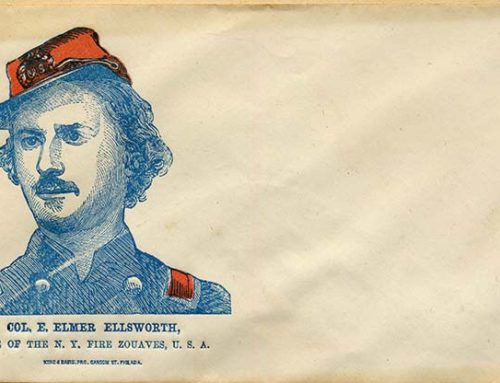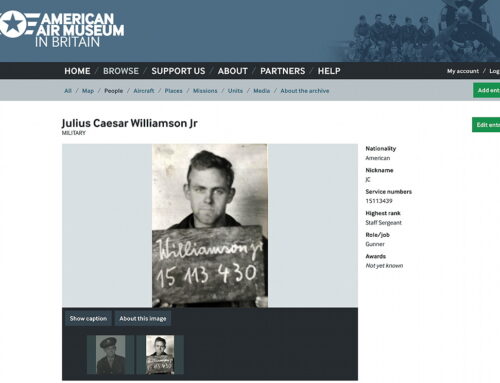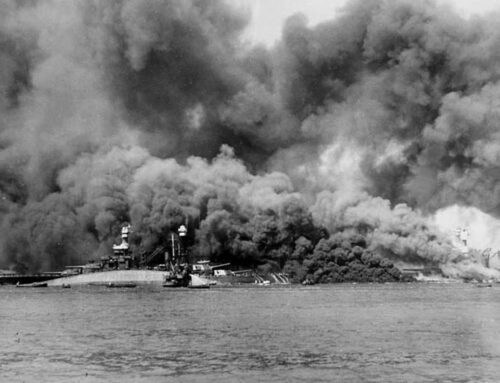Remembering 1LT George W. Owen Jr., U.S. Army Air Corps, and the crew of
Flying Fortress #43-38355 this Memorial Day weekend.

1LT George W. Owen, Jr. (featured image and portrait courtesy Owen family)
I think of him on Memorial Day, when we visit a World War II cemetery or museum, or especially when I (re)watch Twelve O’Clock High, about the air and ground crews of the Mighty Eighth Air Force.
George was born in Chicago on 11 Aug 1922, the fourth child and only son of George Owen Sr. and Grace Belle Wood Owen. George’s maternal grandfather, Alonzo Church Wood, was born in Canada. He enlisted in one of Lincoln’s first calls for volunteers and fought as a Union soldier until he was wounded, discharged, and sent home to Waukegan in 1863.

Chicago Tribune, 12 Dec 1941, p. 15
Alonzo’s grandson was one of the first in line to volunteer for the Army on December 8, 1941. The day after the Japanese attack on Pearl Harbor recruiting offices throughout the country were jammed. Chicago was no exception, but George was accepted that first day. By the time the article at right appeared in the Chicago Tribune on 12 December, George had returned home to 2351 Normandy Avenue and was putting his 19-year-old life in order before leaving for training as a pilot.
George shipped over to England, where he was assigned to the Mighty Eighth Air Force, 493rd Bomb Group, Heavy, 863rd Squadron. The 493rd Bomb Group was the last Eighth Air Force Group to become operational, flying their first combat missions from Debach, Suffolk, on D-Day, 6 June 1944. The Group was nicknamed the Fighting 493rd by Commanding Officer Colonel Elbert Helton, who held the post for over a year. The 493rd flew 161 bombing missions against strategic targets in Germany and tactical ones in northern France, Holland, and along the Rhine.
On 12 Sep 1944, it was time for the 13th mission for George Owen and his crew. Their target was the German Airbase Command at Magdeburg. Aboard Boeing Flying Fortress #43-38355 as it took off from Great Yarmouth were:
- 1LT George William Owen Jr. – pilot
- 2LT Edgar Eugene Blaydes – co-pilot
- 2LT Donald Fahey – navigator
- F/O L.C. Tipton – bombardier
- T/Sgt. Peter M. Trunzo – radio operator/radio operator gunner
- T/Sgt. Roy F. Fiore – top turret gunner
- S/Sgt. Charles C. Gialloreto – ball turret gunner
- S/Sgt. James B. Gray – waist gunner
- S/Sgt. Luther J. Jorg – tail gunner
Over Wackersleben, enemy aircraft shot down the Flying Fortress and its nine young men. The plane crashed at Üplingen, where survivors were captured by German soldiers.

Missing Air Crew Reports, U.S. Army Air Forces, 1942-1947, NARA RG M1380 File 43-38355, page 2. https://www.fold3.com/image/1/28735022, accessed 27 Jul 2010
The Missing Air Crew Report (MACR) states Owen, Blaydes, Trunzo, and Gray were killed when the plane went down. The rest of the crew – Fahey, Tipton, Fiore, Gialloreto, and Jorg – were taken prisoner. The POWs all survived the war, as noted in the World War II Prisoners of War, 1941-1946 database at Ancestry. Each were “Returned to Military Control, Liberated or Repatriated.”
George had just turned 22 when he was killed in action. Owen and Blaydes – pilot and co-pilot – were interred together at Sessenheim Communal Cemetery, in Sessenheim, Alsace, France.
On 15 Feb 1950, Blaydes’s and Owen’s bodies were repatriated and reinterred together at Camp Butler National Cemetery in Springfield, Illinois, USA.
Genealogy makes history personal, and this is an excellent example. Join me today in remembering 1LT George W. Owen Jr., his crew, and their sacrifices.






I go back and read this often. Thanks for compiling all of this, Nancy. Really means an awful lot.
Chris, it’s my honor and privilege to remember your great-uncle George this way.
Thanks for posting. I have a few items from one of these crew members, and now know much more of their story. The items I have belonged to Edgar Blaydes. I found your story on July 4th, nice patriotic day to remember these guys on!
Thanks, Ted. Brave bunch of guys.
Thanks for posting that, Nicole. Did you talk to your grandfather about the crash? Was he taken prisoner?
My grandfather was the ball turret gunner in this crew, Charles Gialloreto. He lived until January of 2008.
Yes, only military service records. I just reread my comments – for an IDPF (WWII) change my “Burial File” to “IDPF” above.
I have a Burial File for my WWI Ancestor Michael Kokoska. It even has hand written letters from his father. I have a WWII IDPF for a WWII cousin who died in France again with a handwritten letter and some other info such as personal items he had. And another who was killed in a plane crash in Florida in Dec 1942 while conducting training exercises. I’m waiting on another IDPF for a different cousin and it has been about 6 months.
Definitely send in a letter but expect to wait a long time. Totally worth it though.
Since you have his MACR, have you looked into obtaining his IDPF (Individual Deceased Personnel File) from the National Archives? Since he died during the war, there should have been a report on him which would possibly include information about his burial overseas; disinterment; sending of remains home; maybe correspondence from the family; etc. I obtained the Accident Report file with photos and the IDPF for my Army Air Force relative who died during WWII.
Just send a letter to: Military Textual Reference Branch (NWCTM), National Archives,
8601 Adelphi Road, College Park, MD 20740-6001, requesting Michael’s Burial File. The letter began Pursuant to the Freedom of Information Act, I hereby make a request for the “Burial File” for, and included his name, branch of military, military service number (if known), Division, Date of Birth, Date of Death, Burial Site in the U.S. and relationship to deceased.